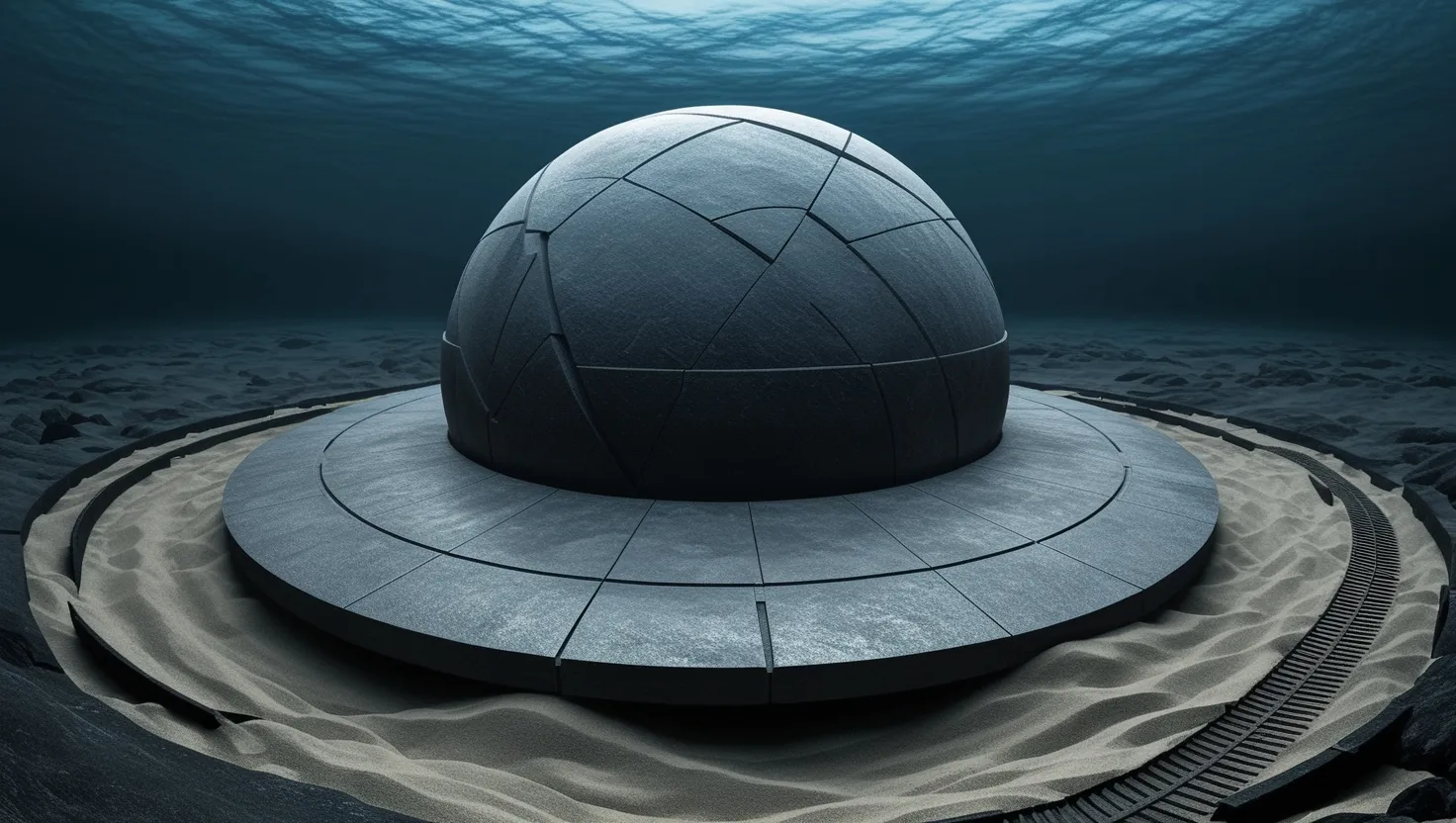The frigid waters of the Baltic Sea have always piqued my curiosity. Picture yourself hundreds of feet beneath gray, choppy waves, surrounded by perpetual twilight. In 2011, a group of explorers mapped a patch of seafloor and stumbled upon something so peculiar it set imaginations everywhere spinning—a massive, perfectly round formation resting 90 meters below the surface. Measuring about 60 meters wide and rising 8 meters above the soft seabed, this feature quickly became known as the Baltic Sea Anomaly.
When I first saw the sonar images, I felt the same jolt of electric curiosity that must have gripped the Ocean X team that discovered it. The object’s shape leapt out—almost geometric, with edges and surfaces that formed right angles, as if drawn by an architect rather than sculpted by nature. The clarity of these lines, coupled with an apparent track or “runway” extending 300 meters from the structure, immediately hinted at something planned, something made. But what kind of process could have fashioned such a thing and left it untouched for so long?
“The most beautiful thing we can experience is the mysterious. It is the source of all true art and science.”
— Albert Einstein
I’ve spent years reading and pondering accounts of ancient shipwrecks, glacial erratics, and geological oddities, but the anomaly doesn’t fit neatly into any familiar category. The first theory that comes to mind, of course, is that it’s just a really big rock, dumped or sculpted by receding glaciers at the end of the last ice age. And indeed, the Baltic’s basin is pockmarked with evidence of glacial activity—everything from polished bedrock to clusters of boulders far too massive to be moved by anything but ice. These erratics, though, usually show the scars of their rough journey. They’re haphazard, mixed with sandstones, granites, and other regional rocks, all looking weathered and out of place.
Yet, the anomaly’s makeup doesn’t quite align with its neighbors. When samples were hauled up and examined in the lab, something unexpected came to light: high concentrations of limonite and goethite, both iron-rich minerals typically formed when iron oxidizes in water. These aren’t strangers to the seafloor, but their abundance here, locked into such a large and uniform body, struck several geologists as odd. Even more, the object demonstrates surprisingly high electrical resistance, a property rare in maritime rocks—especially those riddled with iron.
Why would a structure with so much iron react so little to electric current? What could have preserved such a feature for thousands of years, when the sea’s endless cycle of sediment, salt, and pressure tends to wear even mountains down? The anomaly sits embedded in sediments that seem to predate its presence, almost as if it landed—gently or otherwise—after those layers had already formed. Could the object have migrated, or been deposited by an event we barely understand?
“Science is the poetry of reality.”
— Richard Dawkins
Maybe the answer lies in the object’s geometry. In most natural settings, underwater rocks and outcrops are irregular, pitted, or smoothed by centuries of water flow. Here, though, sonar scans reveal sharp boundaries, and a circularity so pronounced it could have been measured with a compass. It’s easy to see why the first images sent a shiver of speculation through both scientific circles and internet forums. What are the odds that glacial forces, known for their chaotic deposits, would produce something so orderly?
Let’s not forget the “runway”—the pronounced furrow trailing away from the formation. Is it evidence of movement, perhaps as the anomaly slid or was dragged across the ancient seabed? Or is it a rift carved by post-glacial activity, neatly aligned by coincidence alone? Every researcher who examines the images seems to come away with a different interpretation.
Some propose that we’re seeing a type of concretion, a large deposit formed by minerals precipitating out of water over many thousands of years. But concretions, especially ones this size, rarely have geometric surfaces or high concentrations of iron minerals. Could unusual geochemical conditions in the Baltic’s unique brackish waters have created something scientists haven’t witnessed elsewhere?
Others dig into the volcanic hypothesis, speculating about pillow lavas or hard basalt flows. While the Baltic region isn’t famous for recent volcanic activity, isolated basalt samples have been found in the area before—usually glacial hitchhikers rather than native bedrock. But the anomaly’s composition and structure challenge this explanation. Could a rare, long-dead volcanic feature be hiding beneath the mud, preserved and made strange by millennia of immersion?
“There are more things in Heaven and Earth, Horatio, Than are dreamt of in your philosophy.”
— William Shakespeare
As I pore over scientific papers and explorers’ logs, I’m struck by a recurring theme: the limits of our understanding. Sometimes, even with modern sonar and sophisticated lab analysis, we confront things that don’t fit. The anomaly’s high electrical resistance, for example, has sparked wild speculation, even rumors of electronic equipment failing during dives. Is there an undetected magnetic field at play? Or are we simply seeing the quirks of ancient, compacted minerals affecting electric flow in ways we haven’t fully mapped yet?
What makes the anomaly truly interesting isn’t just its shape or its mineralogy, but how it defies easy answers. The more I read, the more I see a conversation unfolding—a debate about the wisdom of labeling extraordinary formations as ordinary, just because we lack irrefutable proof otherwise. After all, what’s more fascinating than a puzzle that keeps resisting solution?
“Somewhere, something incredible is waiting to be known.”
— Carl Sagan
In the past, major discoveries have often started with questions that seemed outlandish at first. Plate tectonics was once dismissed as fantasy. The idea of life thriving in deep-sea hydrothermal vents was ridiculed—until we found entire ecosystems living in utter darkness. Could the Baltic Sea Anomaly be another such case, a chapter in the slow history of redefining our expectations of the natural world?
Would you expect to find a structure so distinct, so sharply defined, hiding in a relatively shallow, studied sea like the Baltic? Can even the best geological models predict every outcome when ice, pressure, mineral chemistry, and deep-sea currents combine over unimaginable stretches of time?
What if the real value of the anomaly lies not just in solving it, but in the reminder that we have only scratched the surface—quite literally—of Earth’s oceans? According to some studies, we know less about the topography of the seafloor than we do about the surface of Mars. How many other anomalies—geological, biological, or chemical—wait to be discovered, challenging our understanding and expanding our imagination?
I wonder what would happen if we applied more resources, sent autonomous drones with the latest imaging technology, or drilled deep cores into and around the anomaly for full chemical mapping. Would we finally settle the debate, or would we only find more questions lurking within the ancient rocks?
“Mystery creates wonder and wonder is the basis of man’s desire to understand.”
— Neil Armstrong
The Baltic Sea Anomaly reminds me, and hopefully you, that not everything has been cataloged or explained. It urges us to look closer, to ask why and how, and to resist easy explanations when the evidence keeps pushing back. The ocean, for all its surface familiarity, is still a vault of stories we haven’t heard.
Perhaps someday, with new technology or a lucky breakthrough, we’ll know what shaped the anomaly. Until then, it stands as a monument to the unknown, inviting curiosity, debate, and perhaps a bit of humility as we confront the vast, mostly unseen world beneath our feet and our ships.
So what do you think could explain the anomaly’s uncanny geometry, its strange mineral signature, or the “runway” stretching away into the murky depths? Theories may come and go, but until someone retrieves a conclusive answer from the bottom of the Baltic, the mystery remains—quiet, immense, and waiting.






